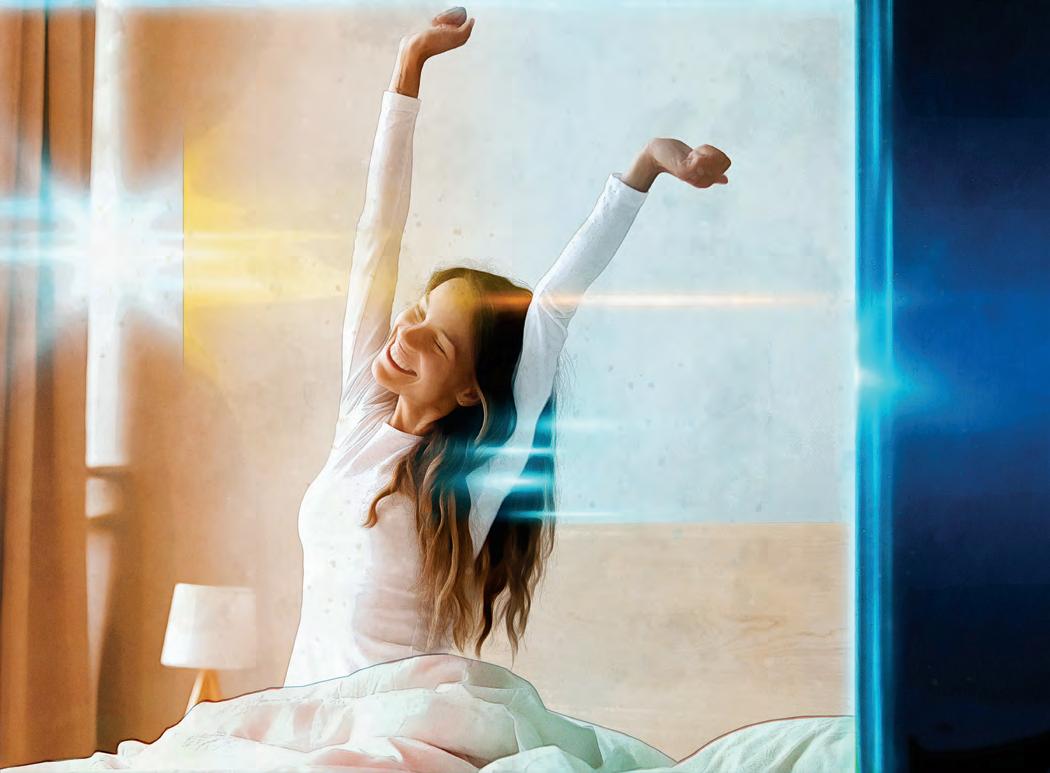
4 minute read
Health
Shining a Light on Winter Days of Gray
How to survive (and thrive) when you’re short on daylight hours
BY KRYSTEN GODFREY MADDOCKS / ILLUSTRATION BY DAVID FIZKES
Starting on November 6, we’ll say goodbye to Daylight Savings Time in the Granite State until March 2023. That means you can look forward to total darkness by 5 p.m. until the groundhog shows his face. Sound cozy? While some look forward to cooler weather and more shut-eye, others find the lack of daylight downright depressing.
The acronym for Seasonal Affective Disorder is “SAD,” and it accurately describes the “winter blues” more than 5% of Americans report feeling this time of the year. As the days grow shorter, symptoms of lethargy, listlessness and agitation slowly seep in. Untreated, SAD can have a devastating effect on your mental and physical health. SAD itself is not a standalone diagnosis but is a type of depression that follows a seasonal pattern, according to the National Institute of Mental Health.
“In order to get a diagnosis of SAD, you need to meet certain criteria over a two-year period,” says Jennifer DeLorme, LICSW, clinical director of Elliot Behavioral Health Services.
It’s important to pay attention to the symptoms you’re feeling as the sunlight diminishes and note any intensification of those symptoms, she says.
“People often verbalize that they’re down in the winter, less motivated and tend to gain weight,” DeLorme says. “Their thought process starts to change, they crave carbohydrate-rich foods in a short time frame, and then the carb crash makes them feel much worse.”
Not everyone who suffers from SAD necessarily experiences the same symptoms at the same intensity level. While some might express hopelessness, others notice an increase in anxiety or sleeplessness. Symptoms can also vary among different age groups, DeLorme says.
Justin Looser, LICSW, ACHE, administrative market director for the HCA Healthcare New Hampshire Market, which includes Parkland Medical Center, Portsmouth Regional Hospital and Frisbie Memorial Hospital, says it’s important to recognize any isolating behavior that you observe in
yourself or your family members. The darkness keeps many people from going outside and getting involved in the community, causing them to pull inward.
Just because it’s winter and difficult to get outdoors, you and your loved ones should continue to pursue social interaction to avoid falling into a deeper rut.
“Always stay social and utilize technology like Zoom, as abnormal as it may feel. People are one of your biggest resources when it comes to [dealing with] any type of mental illness,” says Looser.
Keeping to a routine and planning social activities during the winter can also keep you motivated, he says.
Beating the Blues
If you know you’re prone to SAD, there are steps you can take to prevent it. By moving your body at the beginning of the day, you can get your blood pumping and your feel-good emotions flowing. Whether you opt for a 20-minute walk outdoors, walk in place at home or lift weights in front of your television, any type of movement helps, DeLorme says.
Even if there’s no light outside, you can create a bright environment inside. Light therapy is the No. 1 treatment for SAD. By introducing your body to bright light between 6 a.m. and 8 a.m., you can mimic your natural circadian rhythm. Some of these lights work on timers, so you can choose to wake up to increasing sunlight rather than an alarm, helping you to transition your melatonin (sleep hormones) to serotonin. You can buy light therapy lamps in stores or through online retailers for as little as $20.
“For the people who use it, 70% feel relief,” DeLorme says. “You need to use a special, brighter light that gives off 10,000 lumens.”
Light therapy also exposes you to more Vitamin D, which tends to dip even lower in the winter in the absence of sunlight, Looser says. Taking Vitamin D supplements and other vitamins and minerals, including zinc and Vitamin C, can help elevate your mood before you try other treatments. Before you start taking different vitamins and supplements, you may want to check in with your primary care provider and get your levels checked, DeLorme says.
If natural remedies aren’t helping, antidepressant medications could be an option. However, it’s important to first provide your body what it needs from a natural perspective and talk to your provider about what medications might be the best fit for you.
“[Antidepressants] take 6-12 weeks to build up in your system, so they could have a delayed effect,” DeLorme says.
Should you reach a crisis point, don’t be afraid to reach out for help. Talk about your feelings before they build up. Your primary care provider serves as a good referral source for peer support groups, which can help you manage your depression and anxiety, says Looser. He adds that those struggling with severe depression can also call their local emergency department to get help right away or call the NH Rapid Response Access Point line at (883) 710-6477.
“We can reduce the stigma of mental illness if we talk about it,” he says. “If you had a broken arm, you would talk about it. It’s the same with mental health: we need to normalize that it’s OK to not feel OK.” NH











